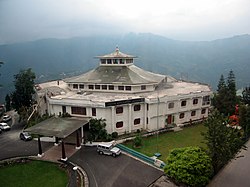Sikkim Legislative Assembly | |
|---|---|
| 11th Sikkim Assembly | |
| Type | |
| Type | |
Term limits | 5 years |
| Established | 1974 |
| Seats | 32 |
| Elections | |
| First past the post | |
Last election | April 2024 |
Next election | April 2029 |
| Meeting place | |
 | |
| Sikkim Legislative Assembly, Gangtok, Sikkim, India | |
| Website | |
| Homepage | |

The Sikkim Legislative Assembly is the unicameral legislature of the state of Sikkim, in Northeast India. The seat of the Legislative Assembly is at Gangtok, the capital of the state. The assembly sits for a term of five years, unless it is dissolved earlier. [1] Sikkim is the second-smallest state in India, covering 7,096 km2 (2,740 sq mi); which accounts for 0.2 per cent of the total area of India. [2] The current population of Sikkim is 6.32 lakhs (630,000), making it the least populous state in India. [3] Established in 1975, the Sikkim Legislative Assembly consists of 32 members elected directly from territorial constituencies using the first-past-the-post system. [4]
Contents
Since the independence of India, the Scheduled Tribes (ST) and the Scheduled Castes (SC) and have been given reservation status, guaranteeing political representation, and the Constitution lays down the general principles of positive discrimination for SCs and STs. [5] : 35, 137 [6] In Sikkim, the Scheduled Tribes primarily include the Bhutia, Lepcha, Limboo and Tamang communities. Twelve constituencies are reserved for the Scheduled Tribes. [7] [8] Among these, reservations are granted only to members of the Bhutia-Lepcha (BL) community. Despite being recognized as Scheduled Tribes in 2002, no seats have been reserved for the Limboo and Tamang communities in the Sikkim Legislative Assembly. Two constituencies (West Pendam and Salghari–Zoom) are reserved for people of the Scheduled Castes [a] (SC). [9] One constituency (Sangha) is reserved for registered Buddhist monks and nuns from the state's monasteries. [10] Seventeen seats are kept open to be contested by Nepalis [b] and other residents of Sikkim. [11]
